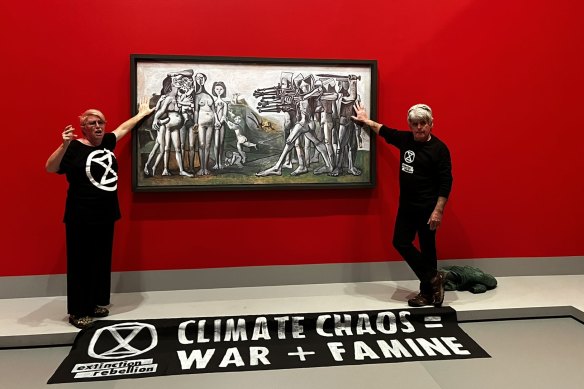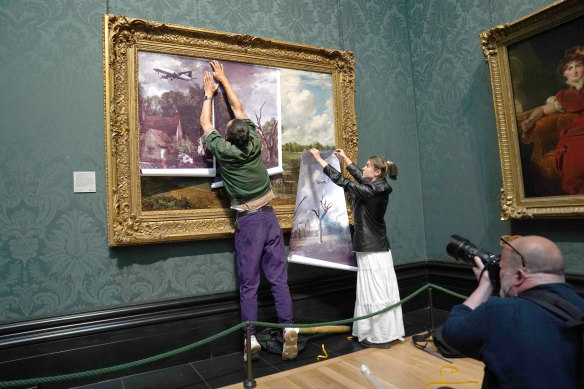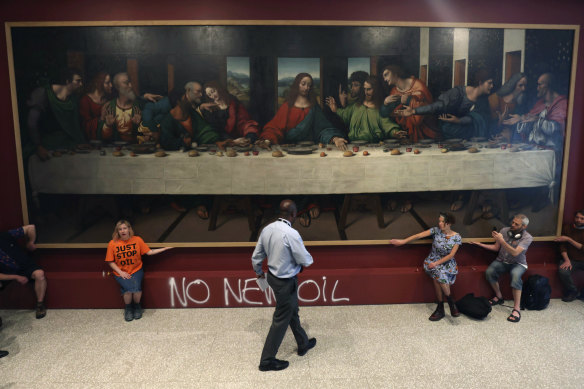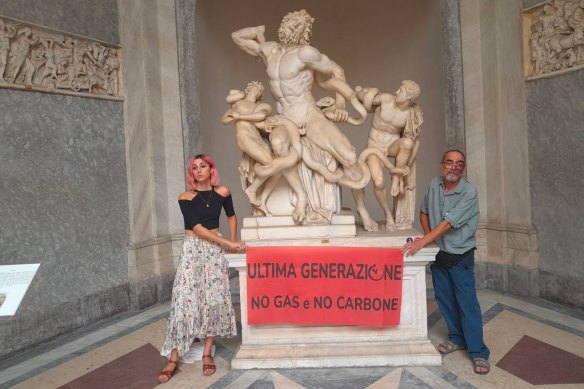An international movement that has seen climate activists smear cake across the Mona Lisa and superglue their hands to masterpieces by Sandro Botticelli, Vincent van Gogh and Umberto Boccioni has arrived in Australia.
Two Extinction Rebellion protesters were arrested at the National Gallery of Victoria (NGV) on Sunday after glueing themselves to the 1951 Picasso painting Massacre in Korea. At their feet lay a banner reading “Climate Chaos = War + Famine”.
Protesters glue themselves to a Picasso painting at the NGV.Credit:Twitter: Jane Morton
The incident follows a spate of similar protests in Europe. And, according to sociologist and activism expert Dr Justine Lloyd, the trend shows that protesters are increasingly exploring avenues for action with “less punitive” consequences, as anti-protest laws targeting the climate movement grow harsher.
“Extinction Rebellion and groups like Blockade Australia have been increasingly prevented from traditional forms of protests like street protests and the blocking of the traffic,” Lloyd says.
This year the Victorian government cracked down on anti-logging protesters and the NSW government introduced two-year jail terms for protesters who block roads and interfere with facilities like train stations and ports.
The two protesters at the NGV glued their hands to the perspex covering of the artwork, so it wasn’t damaged. They were not charged. But they were still able to draw attention for their cause.
Massacre in Korea depicts a firing squad taking aim at a group of naked women and children. It was painted by Picasso, a pacifist, in response to the Korean War.
Lloyd says demonstrators are clearly targeting artworks that enhance the poignancy of their message.
“If Picasso was alive, I think he would have been painting pictures about climate, the climate emergency and about the kind of involvement of the fossil fuels industries and their connections to war.”
Protestors covered John Constable’s The Hay Wain with a fiery alternative vision of the landscape in a protest against the fossil fuel industry.Credit:Kirsty O’Connor
Activists armed with superglue and art theory did the same during a series of protests in the UK and Europe earlier this year.
At London’s National Gallery in July, Just Stop Oil activists covered The Hay Wain, a bucolic 1821 landscape by John Constable, with posters depicting the same scene on fire with belching smoke stacks in the background.
The next day, activists glued themselves to the frame of The Last Supper – a 1520 copy of da Vinci’s masterpiece by his student Giampietrino – at London’s Royal Academy.
Protesters from “Just Stop Oil” climate protest group glue their hands to the frame of a copy of Leonardo da Vinci’s, ‘The Last Supper’, inside the Royal Academy, London.Credit:James Manning
Soon after, activists from Italian climate action group Ultima Generazione (Last Generation) targeted Botticelli’s Primavera, which features 500 plant species, as a protest against biodiversity loss.
Members of the group also entered the Vatican Museum and secured themselves to Laocoön and His Sons, a 2000-year-old Roman statue depicting a priest who urged his people to burn the Trojan Horse as it entered Troy but was ignored.
Protestors from Italian climate activist group Ultima Generazione glued their hands to a 2000-year-old statue in the Vatican Museum in August.Credit:Ultima Generazione
“We must immediately understand that there will be no art in a collapsing planet,” said an Ultima Generazione protester who glued herself to a Boccioni statue in Milan. “This is why we ask cultural institutions to take sides with us and to put pressure on the government.”
The protests are also a creative way of getting media coverage. As a spokesperson from Just Stop Oil told The New York Times, when the group invaded oil terminals no one paid attention; but news that they’d superglued their hands to the frame of van Gogh’s Peach Trees in Blossom went global.
Targeting famous artworks certainly guarantees international coverage, but Lloyd says the activists’ “complex message” is often swallowed by the spectacle. And the protests have drawn ire too – most notably from then-UK culture minister Nadine Dorries.
Surrealist Australian painter Reg Mombassa, who recently opened an exhibition in Sydney focused on extinction and the climate crisis, says he “wouldn’t be keen on people destroying artworks” but he does admire the work of activists as climate change “accelerates alarmingly”.
“It’s often quite risky and stressful for them,” he says. “I’m not sure whether it changes anyone’s mind who doesn’t believe there’s a problem with the climate. I guess it gees up people who are concerned about it.”
The Museum of Contemporary Art, the National Gallery and the NGV didn’t respond to questions asking if they were concerned about more activists targeting their works.
A spokesperson for the Art Gallery of NSW said: “While the concerns of the activists are shared in the community, their current strategy for raising awareness poses great risks to the artworks that art museums are responsible for preserving for future generations.”
A cultural guide to going out and loving your city. Sign up to our Culture Fix newsletter here.
Most Viewed in Culture
From our partners
Source: Read Full Article




